Georgia Little Shield, the shelter's director, invited me out to Standing Rock to observe some domestic violence prevention workshops they were doing in the communities with Cecilia Fire Thunder and Carmen O'Leary, two famous activists. Unfortunately, due to some snow and severe cold the workshop was postponed until after I left. So, I had to stay indoors for the first few days and then I got to know the eastern part of the reservation for the rest of the time.
Below you'll find lots of photos of Standing Rock and some of my impressions. I will follow with another diary strictly about the shelter.
You'll see that this has taken me a while to write this. I came down with the flu after I got back, and also had some more thinking to do about what I saw.
Before continuing, I want to add that I had the privilege of accompanying two wonderful French journalists, Anne Senges and Stephane (didn't get his last name) who are doing a story on the shelter and Standing Rock for Marie Claire magazine (they found out about the story on DKos!) and Getty images, which will have the story in English along with the photos for editors.
Because they were so taken with the problems on Standing Rock, they will provide us with the entire article and photos free of copyright restrictions, because they feel it will help raise money for the shelter. So, in about March I'll be doing a diary that's a reprint of that article, or they will post it directly here. They got some amazing individual stories, and the photographer is one of the best known in France, so I am excited about that.
First, lets take a look at Standing Rock in the winter. I arrived to blowing snow and below zero temps at night. Georgia Little Shield was supposed to pick me up in Rapid City, but sent Tannekkia Williams instead because of a death in the family. Going into Rapid City was bad advice - I would never have suspected that anyone would think nothing of driving 5 hours to pick someone up at the airport (Bismark ND would have been closer to Standing Rock, but Georgia lives on the Cheyenne River Rez).
Even though Tannekkia, who is a shelter volunteer and board member, grew up in Minneapolis and is only part American Indian, she married an enrolled member of Standing Rock (and then become a domestic violence victim), and is quite assimilated into the Lakota culture. If you went to the panel at the Netroots Nation, you might remember her. She is a very articulate spokesperson for the shelter and anti-domestic violence efforts on Standing Rock.
Tannekkia greeted me with the joyful announcement that she had seen 30 spotted eagles on her trip down, and one even smashed into the side of her car. Seeing a spotted eagle is a good omen according to Lakota beliefs.
After we had dinner in Rapid City, Tanekkia took me to nearby Bear Butte, one of the two major Lakota sacred sites in the region (the other being Devilstower), even though it was dark and wet snow was falling. After a short drive up the hill and a very short hike we reached a clearing near the summit which was really magical feeling. Despite the weather and the darkness, it felt incredibly peaceful, and pretty soon the clouds parted to reveal a nearly-full moon, which lit up our surroundings for a few minutes. In the moonlight the skeleton of a sweat lodge was clearly visible, as was a very large a pile of stones next to it. Tannekkia explained that elder men used that lodge when they went up there. I imagined the generations of people going to that site in total reverence for nature. She had also pointed out tobacco prayer flags along the way, and we both offered some of her tobacco to a big boulder. We both left feeling peaceful and refreshed. I had the impression that it is a very healing place.
During the now six-hour trip back to Standing Rock in the blowing snow, we found out that the workshops for the whole week had been postponed, which also meant that Georgia would be holed up in her trailer on the Cheyenne River Reservation for much of the week as well. The Tribal Offices also shut down for most of the week. Such is winter in the Dakotas.
Not to worry, there was always the incredible scenery.
A typical view driving around Standing Rock in the winter.
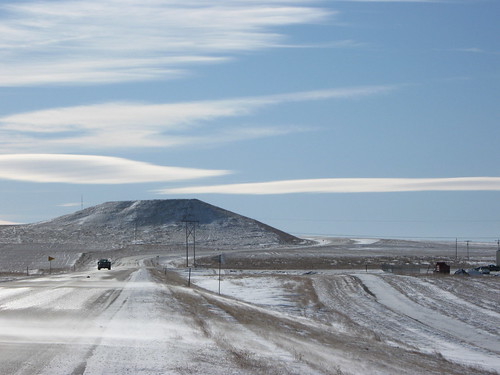
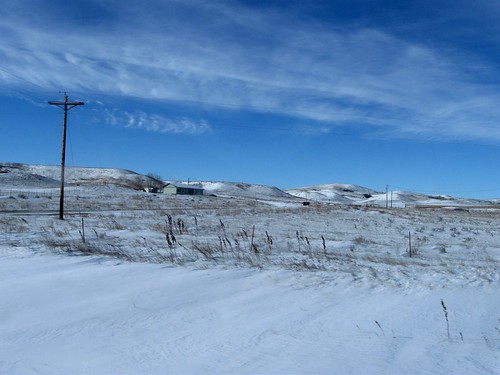
Little House on the Prairie!
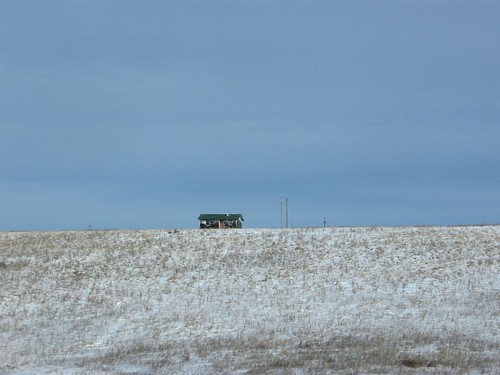

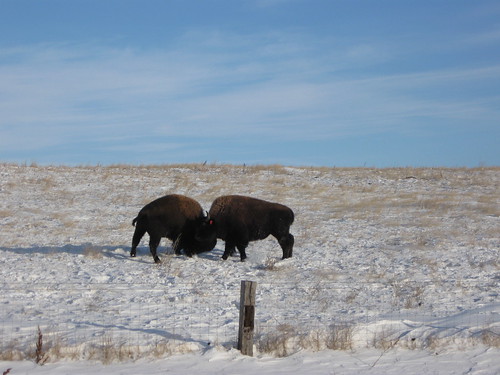
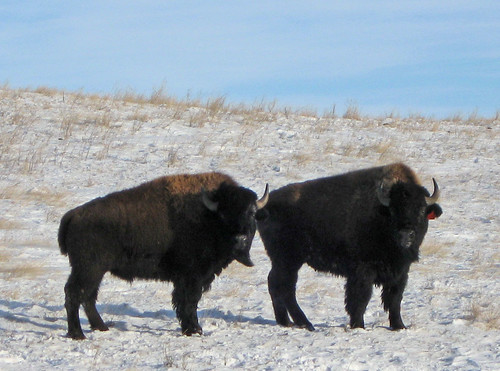
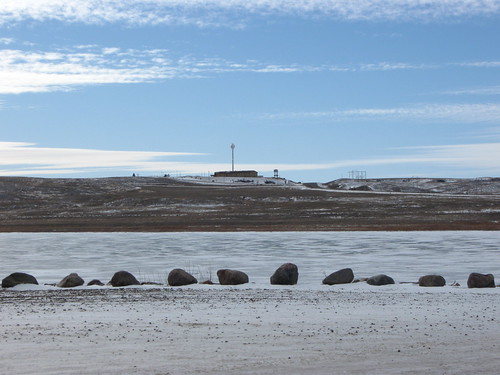
Frozen Missouri River from Mobridge SD. In Lakota it's Lake Oahe. This part of the river was originally a stream but was flooded for a damn, which drove dozens of families from their homes and killed a lot of trees, from what I could see of the stumps farther up river. The Tribe receives monies each year in supposed reparations for this. This year they decided to use some of them to fund a sexual assault response personnel, which will probably transform Tannekkia from a board member and volunteer to a full time staff member with an office in the Tribal Council building. On the hill you can also see the smaller casino on the Reservation.
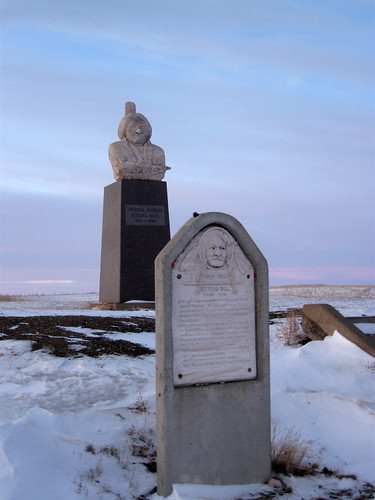
Sitting Bull Monument
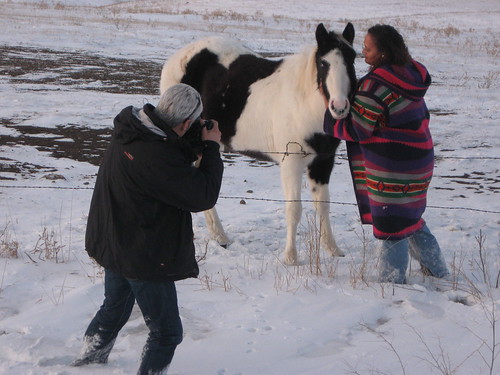
Tannekkia in an impromptu shoot
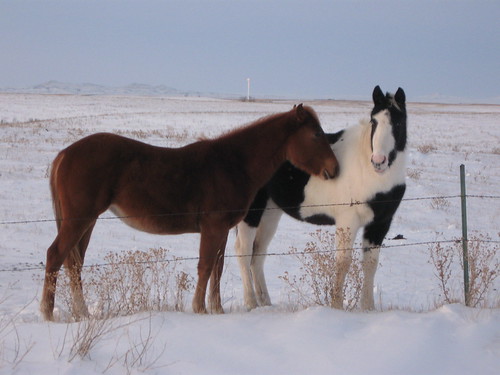
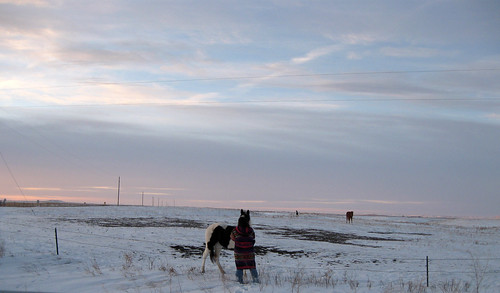
Big sky at dusk
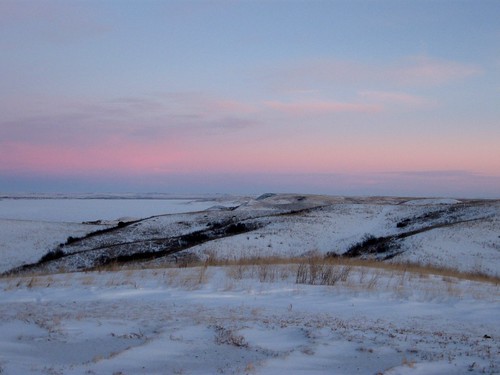
Prairie Pastels
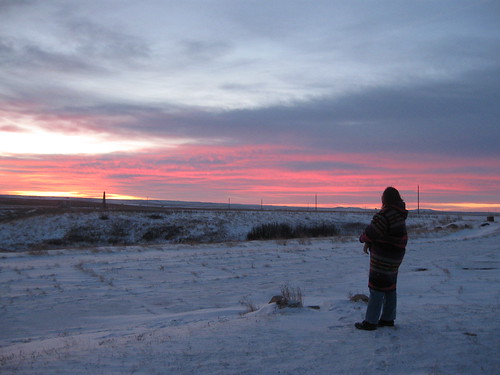
Looking at the Sakagewea monument at sunset
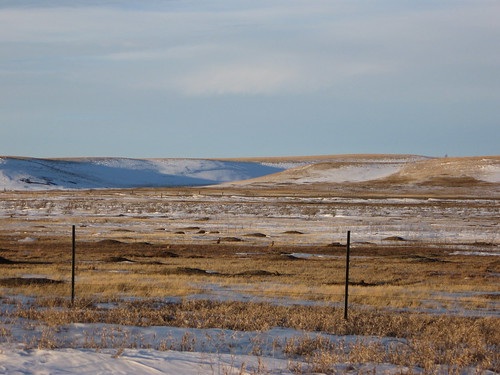
A prairie dog village in winter
General Information from the Standing Rock website
Standing Rock Reservation Eight DistrictsDistrict Population
1. Fort Yates, North Dakota 1,961 5. Little Eagle, South Dakota 695
2. Porcupine, North Dakota 219 6. Mclaughlin (Bear Soldier), SD 758
3. Kenel, South Dakota 259 7. Bullhead (Rock Creek), SD 692
4. Wakpala, South Dakota 707 8. Cannon Ball, North Dakota 847
Tribal/Agency Headquarters: Fort Yates, North Dakota
Counties: Sioux County, North Dakota; Corson, Dewey and Ziebach Counties, South Dakota
Federal Reservation: 1873
Population of enrolled members: 10,859
Reservation Population: 6,171
Density:: 0.4 persons per square mile
Labor Force: 3,761
Unemployment percentage rate: 79
Language: Lakota/Dakota and English
Lakota/Dakota Bands: Hunkpapa, Blackfeet, Yanktonia, Cuthead
Land Status: Acres
Total Area 2,300,000
Tribal Owned 866,072
Tribal Owned Allotted 542,543
Total tribal owned 1,408,061
Non-Indian Owned 1,283,000
Reservoir Taken area 55,993
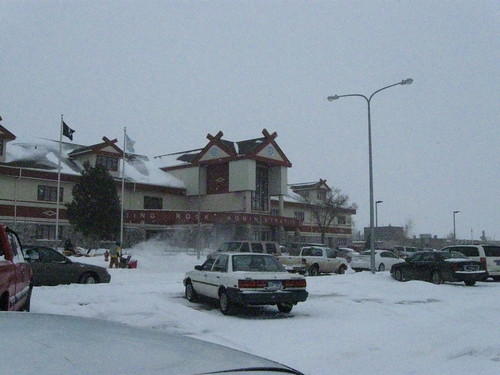
Tribal Council Building
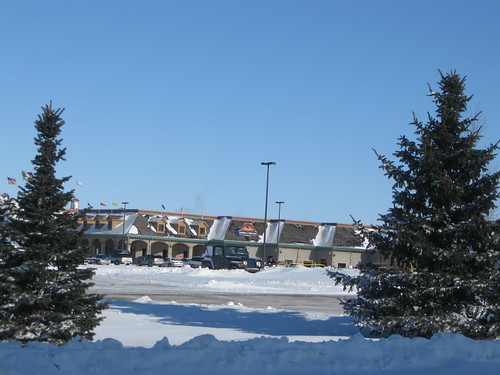
Prairie Knights Casino in Ft. Yates. There is a smaller one near Mobridge.
Housing
One thing we learned during the shelter fundraiser is that there is a chronic housing shortage on the reservation, which had left me with the impression that all the housing stock would be terrible, but it's not. There still isn't enough of it, but at least much of it is not as terrible as I thought it would be. Some of it is bad, but much of it is just fine. However, often more than one generation must live in a house, and people don't have a choice of what neighborhood they will live in. It's kind of reminded me of the situation in Cuba.
You do see this:
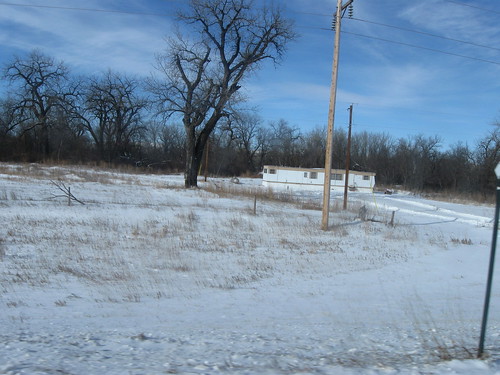
But it seemed that there was more housing like this:
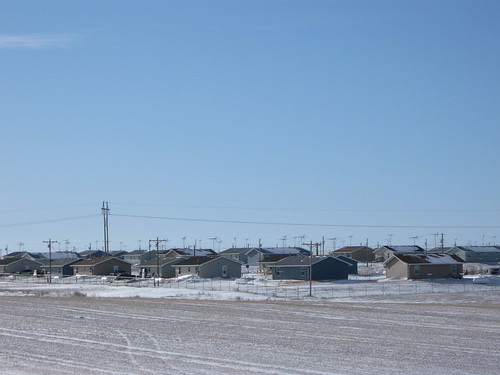
Bear Soldier South
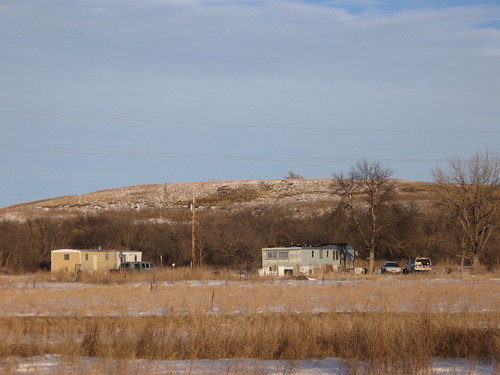
Wakpala
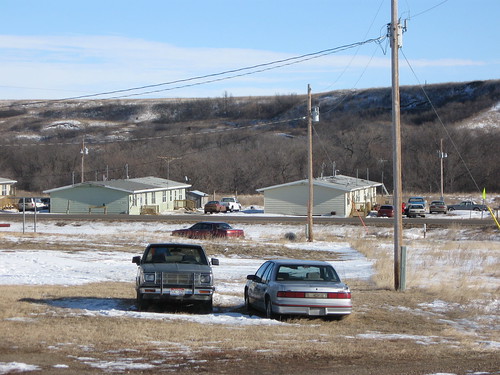
Wakpala
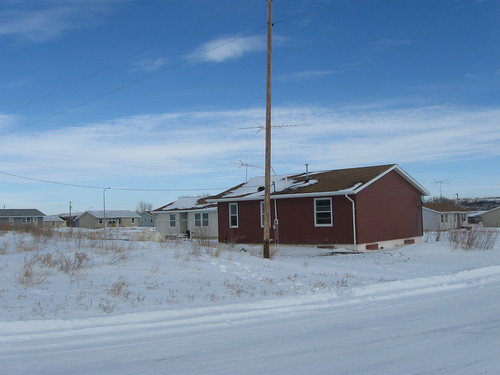
Here's what the Standing Rock website says about the housing situation:
The Standing Rock Housing Authority constructs and manages over 650 homesfor Tribal members living on the reservation. This includes homes on scattered sites built through the HUD Mutual Help home ownership program on individual land or Tribal land leased for homesites. The other housing in the districts is low-income HUD Low Rent for individual Indian residents in reservation communities. As private housing stock is limited, some of the Standing Rock members own their own homes in the rural areas through other private financing. The Bureau of Indian Affairs and the Indian Health Service have some housing available in McLaughlin and McIntosh for their employees.The Tribe plans to build a number of apartment complexes in the future.
The need for housing is great on Standing Rock. The Tribe is looking into Habitat for Humanity homes and the government Home Grant project The number of persons per household in the Standing Rock Service Area is 4.60 compared to 3.27 for the State of North Dakota and 3.27 for the State of South Dakota. The number of persons per family for U.S. All Races is 3.80.
Social Customs
Sometimes, when you are looking at one thing about a group of people, in this case domestic or other interpersonal violence, it's easy to lose track of the more basic, and beautiful things about it. I was touched by the fact that people ascribed great meaning to gestures that we would consider small, such as siting an eagle in the sky, or getting a small gift of tobacco from someone entering the house.
I also found people's appreciation for the earth and its inhabitants profoundly spiritual, no matter what other behaviors they exhibited on top of that.
Given this, when we were going around with the journalists, Tannekkia suggested that we take people either a pouch of tobacco or some coffee (Folgers seems to be the only brand around, by the way). So we did, and you could see by people's faces that this small gesture was significant.
When they went over to Georgia's house on the Cheyenne River Reservation, Stephane gave her husband Norman a cigarette, which he thought Norman would smoke. Instead, he put it behind an eagle feather he had propped up inside of a picture in the kitchen so that he could pray on it the next time he was inspired to do so (usually outside in nature).
Here is the cigarette under the eagle feather:
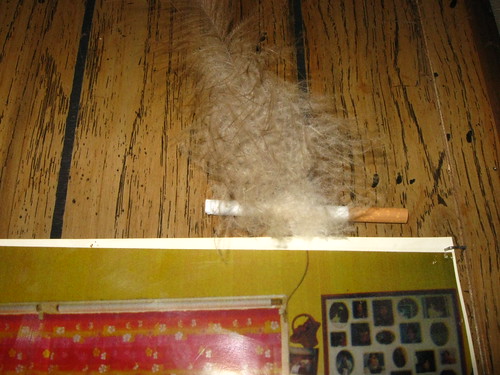
Two other things common in people's homes are star quilts and dried prairie turnips.
Here, a woman sews a star quilt, which she will sell on the Reservation. Some people also sell them on the Internet, at sites like eBay.
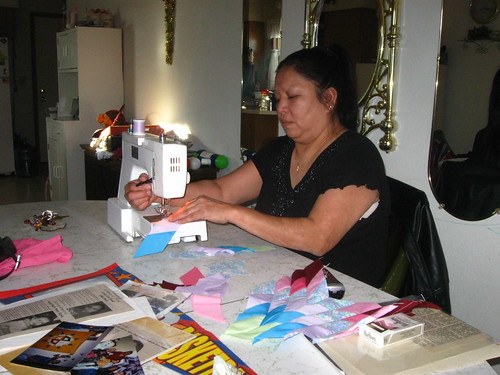
From what people told me, the turnips are more for decoration, unless you're really hungry and bother to soak them. They are bland and easily absorb flavors of other foods.

This is just a small taste of what is hidden just below the surface of all the poverty and sickness on Indian reservations.
The Reservation as a Network of Kin and Fictive Kin
Another lovely thing about the Lakota people is their system of extended fictive kin, as anthropologists would call it. People easily "take" people as adopted brothers, sisters, mothers, fathers, etc. You can become someone's adopted relative by ceremony or just by them saying so. So, Tannekkia's father-in-law "took her as his daughter", so she thought of and referred to him as her father. It did get me a little confused when people would talk about all these brothers and sisters, sometimes saying "adopted" as a preface and sometimes not, but it was a really, really nice custom. Everyone had adopted kin that they took seriously as such.
I also thought it was lovely that people always used kinship terms when referring to someone they were either close with or respected a lot, perhaps for being an elder. For example, I became auntie to Tannekkia's kids. However, even with Georgia's two foster daughters, the youngest one, who was eight, would call her older sister, who was 17, "sister." Elders are usually called Auntie, Uncle, or Grannie or Grandpa. I really liked that.
This is the living form of the thought that everyone and everything is connected to everything else -- you could conceivably think of everyone in your group as a relative. From a larger perspective, everyone is truly your relation.
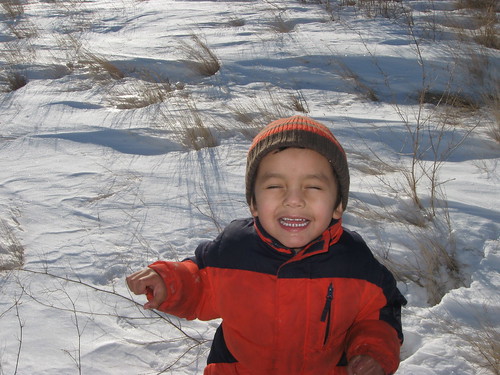
Tannekkia's four year old Isaac playing in the back yard.
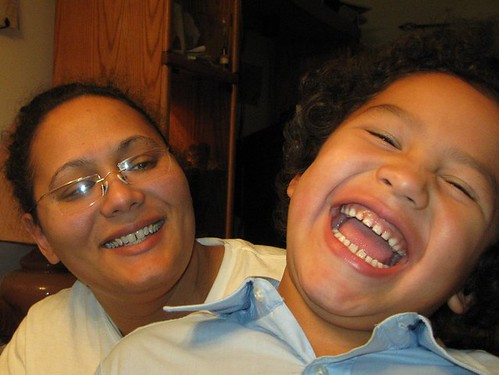
Tannekkia and her son Vaughn Edward. Cute kids, eh!
Interpersonal Violence
Yes, this is an endemic problem on all reservations, along with alcoholism, drug abuse, diabetes, cancer, and heart disease, and the other maladies associated with poverty. Standing Rock had been especially bad because it only had 2 officers operating in a place the size of Connecticut, so while I was there the Bureau of Indian Affairs was conducting a "surge." They will eventually hire more officers to police the reservation, which should help.
Up until now, there was a lot of impunity, complicated by jurisdictional issues around the border area of Mobridge. All you had to was cross the Missouri River, or Lake Oahe, and you were out of the tribe's jurisdiction. Then the crime had to be of a certain severity before the FBI would bother to take the case (see the Amnesty International Report, Maze of Injustice at the link on the right for more info on this).
The interpersonal violence issue presented itself as soon as I got to Standing Rock. Tannekkia and her brother, who live in college housing on the Sitting Bull campus, had been woken up early in the morning a night or two before I arrived by a woman next door who had been battered by her son. She had been visiting, and they both started to drink. He ended up punching and kicking her so hard in one of her eyes that it burst. Tannekkia and her brother separtely described the woman as crying, with one eye crying tears and the other one crying blood. That visual was hard to shake. They also told me that it had taken 20 or 30 minutes to convince her to call the police because she was afraid she would get into trouble for drinking, even though she probably will never see out of that eye again.
The kid finally got arrested two weeks after the incident. The case is being passed up to the federal level (read, FBI) due to the severity of the woman's injuries.
As if that weren't enough, the woman in the photo told us a story of how she had been brutally raped and beaten in 1980 - even her pelvis was broken, and she had been dragged around behind a pick up truck. Although she wouldn't admit it, her current husband was also beating her (he had broken her arm a month or two before, but it had healed before we got there), and they both drank.
Her attacker had gotten 18 years in jail but when he was released he came to live in her neighborhood. Due to the housing shortage she cannot move away from him or the three pedophiles that live in the neighborhood. She seemed to have PTSD to me, judging by the way she was acting when she was telling this story. I would have had it too, I thought, and I'd probably drink as well if I were in her situation.
The woman's daughter, she told us, had been a victim of a horrific incident of domestic violence that involved her husband locking her in the basement naked for 2 weeks, and so severely beating her that she suffered brain injuries. After 2 years she still suffers occasional seizures.
This is the neighborhood where Jackie Brown Otter lives - remember, she is the one with the sister, Ivy (whose Lakota name is Pretty Bird Woman), who was found raped and murdered. Well, there were two more cases of young women being raped, murdered and thrown into the field behind the complex in previous years as well.
And all of this takes place within a social context where people gossip so much about each other that it has destroyed all trust, so it's very difficult for people to work together to do things like have a healing circle.
That last element really had me stumped.
In my opinion, having done research on culture and trauma, the community really needs to start take PTSD much more seriously, since it is directly related to increased personal violence, depression, and self-medicating behaviors, like drug and alcohol abuse. Many returning Iraq vets exhibit this type of behavior, for example.
Wellbriety Journey 2009
It seems to me that a program designed to employ already-existing cultural tools would be especially helpful, and I like this new movement started by White Bison in Colorado. It's called the Wellbriety, and it uses American Indian cultural tools to help people overcome their addictions and other problems. There is an article about it below.
This year Wellbriety is embarking on a cross-country trip called the Wellbriety Journey of Forgiveness. First, it is going to ask President Obama to issue an apology for sending Native Americans to boarding schools. There is precedent for this in Australia and Canada, so it's not a far-fetched request. However, on the advice of a group of elders, they will be forgiving the U.S. whether or not the government issues an apology. Pretty interesting, since the boarding schools and genocide planted the roots of the cycle of violence we see on reservations today.
I will not say that I have any kind of in depth knowlege after two weeks on the reservation in the winter, so I'd like to go back in the summer and see what I think then. It's a very interesting and beautiful place, even though a lot of things about it area also pretty depressing.


































